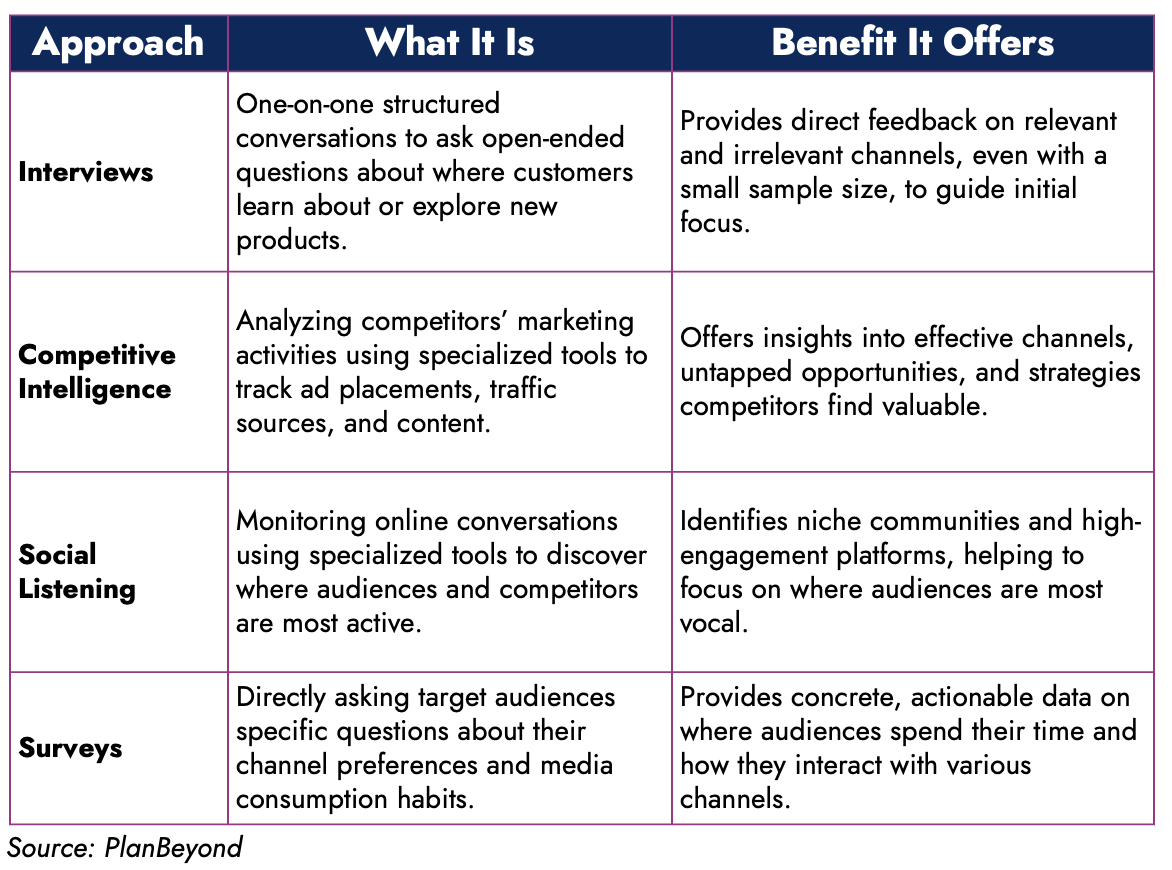Most organizations wish they had more money to spend on marketing. Either to build awareness, or help drive customers to close. But, up to 75% of the marketing budget they do use is likely inefficiently spent. Poor choices in marketing channels, or spreading resources across too many channels, results in businesses failing to connect with their target audience.
This is where market research becomes a game-changer. By uncovering where customers are most active and engaged, organizations know where to best allocate limited budgets. Businesses improve acquisition costs, all while more efficiently fueling their funnels.
Identifying Relevant Marketing Channels Via Market Research
There is no single solution for exploring the ideal marketing channel mix. You need to tailor your exploration based on how much you do, or don’t, know about your customer.
1. Initiate Marketing Channel Exploration With Interviews
Interviews are ideal for identifying marketing channels that should be on your radar. Or, for providing initial validation that you’re on the right track. One-to-one conversations via structured, guided conversations let organizations ask open-ended questions to explore potential channels.
For instance, if you’re unsure about which platforms are relevant, ask about where customers go to learn about, or explore, new products. This could bring review sites or other niche digital properties to your attention. Meanwhile, if you’re wondering if it’s worth allocating any budget to conferences or events, explore what events, if any customers plan to attend. On the flip side, you can also explore if certain channels have lost relevance or have developed negative associations.
Feedback across interviews tells you exactly which marketing channels you should, or should not, consider. While you will be working with a limited sample size, feedback may be so consistent that you know after just 8-10 interviews where to focus your attention. Other times, you’ll have just enough intel to set the foundation for further validation.
2. Corroborate With Competitive Intelligence
Competitor analysis is extremely valuable when isolating marketing channels for one key reason: it lets you learn from businesses targeting similar audiences. Closely monitoring competitor channel activities, and implicitly their spend and resourcing, gives you insight into what others perceive as valuable marketing channels.
This can include using online tools like SEMrush, BuzzSumo, or SimilarWeb to track competitor ad placements, traffic sources, and top-performing content. Or, it can include a review of activities across owned social media platforms to gauge frequency and activity levels. Relatedly, analysis of content types tells you what type of information they think is worthwhile to produce while a review of partnerships with influencers, brand ambassadors, or other third parties indicates key industry players you should have in your sights.
Analyzing competitor activity across channels provides evidence for channels that work, ones that don’t, and also untapped opportunities that you could use to differentiate yourself.
3. Layer In Social Listening
Another supplemental tactic to consider when exploring potential marketing channels is social listening. By monitoring online conversations to discover where brands, competitors, or industry topics are discussed, organizations pinpoint exactly where their audience is active.
Tools like Hootsuite, Brandwatch, or Sprout Social help identify the specific platforms where your audience is most vocal or active as well as channels that spark the highest engagement for your competitors. Social listening is especially beneficial to isolate niche online communities that may be small, but are extremely passionate and loyal. By finding these communities, and where they like to spend their time, you have key intel on where to focus your channel strategy.

4. Validate With Targeted Surveys
Surveys let you determine, with confidence, where your target audience spends their time and how they interact with various marketing channels. The beauty of using surveys lies in their directness. You can ask very specific questions and receive concrete answers about where exactly your audience is, and isn’t, spending their time.
Use surveys to explore which particular social media channels customers engage with, and how often. Or, ask questions about what type of media—videos, blogs, podcasts, infographics—they most like to consume. If you’re considering investing money with particular influencers, online sites, or publications, ask your customers how frequently, if ever, they engage with these properties. And, if you did some initial exploration via interviews, competitive analysis, or social listening, you’ll have a foundation for what exactly you should ask.
When reviewed, survey findings will give you two pieces of critical insight. First, you’ll confidently know which channels you audience does engage with, and how frequently. Additionally, you’ll see how if different customer segments have different channel mix patterns.
Using Research Findings To Determine Budget Allocation
Understanding your audience’s engagement pattern tells you how to prioritize your marketing channel spend.
Focus on Primary Channels: Look at your research findings. The places where customers show high activity, relevance, and engagement are the places to allocate the bulk of your budget. Allocate most of your budget to the most relevant 2-3 channels. For example, double down on Instagram and YouTube ads if these platforms are where your audience spends most of their time. This ensures you focus ad spending on the right places, and with enough budget to reach your audience repeatedly.
Test Emerging Opportunities: Did your research uncover less mainstream but potentially promising channels? Put aside a small amount of budget to test them, and track results along the way. For instance, if you see a niche interest in a certain Reddit community, put a small amount of budget on promoted posts or AMA events to test the waters.
Segment Your Audience for Channel-Specific Targeting Not all customer segments behave the same. If your research showed different segments engage with different channels at different rates, tailor your activities accordingly. For instance, a B2B company may use less-expensive Facebook ads to build broader awareness across an industry’s audience, but then use focused LinkedIn ad buys to directly engage segments involved in the initiation process.
Measure, Optimize, and Evolve
A successful channel strategy comes down to a balance of data, testing, and optimization. By carefully researching your audience, testing emerging opportunities, and tailoring efforts to specific segments, you’ll create a sustainable approach to engage your customers.
Of course, keep in mind that the right marketing channel mix may change. Your audience’s tastes might adjust. Or, new channels, influencers, or digital properties might emerge. Regularly check in with customers to learn where they spend their time, or how they learn about new products. This will let you naturally evolve with your customers to maintain the right mix over time.






